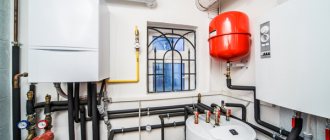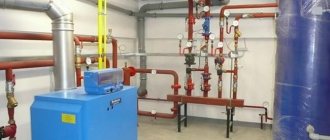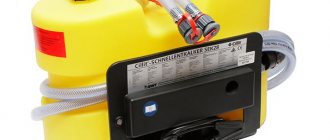A gas boiler is often located in houses outside urban areas, in small businesses and shopping centers. Its task is to maintain the required air temperature in the room, and in some cases, to provide hot water supply. Smart automation in modern boilers turns on heating only if the temperature of the coolant (usually water) or the air in the room drops below a predetermined level. In this way, it is expected not only to save fuel, but also to reduce wear and tear on the device as a whole. In certain scenarios, so-called clocking may occur. Let's talk about him.
An unexpected problem is the boiler clocking.
As you know, if you constantly turn on and off any device without a good reason, it will quickly fail. This is the fate that most often befalls automatic gas boilers. The automation is unable to adapt to changing conditions; it activates heating every 10 (or even 5) minutes. The equipment cannot withstand such surges and literally burns out in a few months. Oddly enough, this phenomenon especially affected wall-mounted gas boilers, which are sensitive to temperature changes.
This phenomenon quickly took root among users of gas boilers and craftsmen under the name “clocking” - too frequent repetition of the heating-cooling cycle.
Questions and answers
Not only does my boiler go out 10-15 seconds after ignition, but the red light on the display also lights up. The boiler is imported, but there are a lot of reasons for this in the specifications. What should I do?
It is better to call the gas service, since the red light indicates a massive breakdown, which blocks further use of the boiler in emergency mode.
When there is a strong wind outside, it is almost impossible to light the boiler in my house. Not only does it go out, but re-ignition fails. What is the reason?
Installing a deflector will help you, which prevents air masses from entering the chimney and neutralizes the formation of reverse draft. The device is simple but very effective.
I start to light the boiler, there is a characteristic pop (it seems like it has caught fire), but after a few seconds I look out the window, and there is no flame there at all. What could it be?
This picture is typical for the gas valve to operate and automatically stop the gas supply to the burner. You need to call a specialist who will inspect all the elements involved in ignition.
To summarize, it is important to note that turning off a gas boiler has many reasons, which cannot be identified or eliminated on your own. It is best and safest to call the experts who will quickly solve any problem. It is not recommended to open the boiler yourself, inspect its parts and make repairs that may be unsafe for the further use of gas equipment.
Defect or incorrect setting?
An unpleasant phenomenon is often viewed as a technical malfunction, but it is not. The temperature sensor is triggered by a change in temperature - the burner turns on - the boiler heats up. Everything works correctly and in accordance with the specified conditions. And the fact that the cycle irrationally uses the boiler resource is the problem of the user, not the underlying program.
Thus, clocking is not a defect, but the result of incorrectly adjusted temperature ranges or a poorly organized heating system. There are several most common reasons for the boiler to not operate correctly:
- Incorrectly installed thermometer.
- Small temperature ranges.
- Unregulated burner.
- Low heat capacity of the heating circuit.
It is these problems that are a frequent reason to call a specialist. Of course, you can do it on your own - just follow simple tips.
Checking the heating system: pipes, radiators, circulation pump
Simplified diagram of CO with a circulation pump at the boiler supply.
If the boiler power meets the requirements, you should pay attention to the elements of the heating system (all valves and thermostats, radiators, pipes); perhaps something is blocking or slowing down the movement of the coolant, make sure there is no air.
In systems with forced circulation, the cause may be the circulation pump. Firstly, in order to operate the boiler in vacuum mode, it is recommended to install it on the supply side (provided that the pump is designed for a temperature of 110-115°C). Secondly, it is worth trying to increase its speed; perhaps the speed of movement of the coolant is not enough and it lingers for a long time in the boiler heat exchanger.
Positioning the thermometer correctly
There are two types of thermostat:
- Built-in - measures the temperature of the coolant, does not respond to external conditions.
- Remote - measures the air temperature in the room, does not react to the temperature inside the boiler.
With the first type, everything is clear - nothing can be changed, the thermometer does not involve transfer. The remote type must be positioned correctly - otherwise, every ventilation or operation of household appliances will disrupt the heating operation throughout the house.
Experienced craftsmen advise placing the device in the part of the room that cools most slowly. As a rule, it is located at a considerable distance from the boiler, so heating is also extended over time. Reducing the temperature to the lower limit will mean cooling the entire room - the heating will begin to operate normally.
In order for the burner to perform long, uniform cycles, you should not install a thermometer:
- Near windows, doors, cracks in walls.
- Near household appliances.
- Close to the floor or ceiling.
- In the basements.
The gas boiler is ticking, what should I do? — Handyman's Handbook
Today, gas heating boilers are the most common devices for heating homes. Choosing the right boiler based on power and other necessary criteria will help you avoid many problems in the future.
The following functionality is usually considered as selection criteria:
- Heating circuit diagram. The subsequent choice of the boiler depends on the choice of the type of circuit, which may be energy dependent or will not require electricity for its operation.
- Single-circuit or double-circuit boiler. You need to decide to purchase a separate indirect heating boiler or a double-circuit boiler.
- Combustion chamber type. They are open or closed. Popular wall-mounted boilers usually have a closed chamber and a coaxial chimney. To effectively remove combustion products, a forced draft fan is installed. For open circuits with non-volatile boilers, a chimney with good natural draft is needed to operate the open combustion chamber.
- Selecting the boiler type. Depending on the area of the premises and the heating scheme, the type of boiler selected is wall-mounted or floor-standing. Typically, for rooms with an area of more than 300 m2, a floor-standing boiler is installed.
Why does my gas boiler keep switching off? Causes and solutions
The gas boiler system is responsible for several functions - heating the room, providing hot water supply. Sometimes, during the coldest period, a malfunction may occur, leading to equipment shutdown. An unpleasant situation most often occurs during the heating season, so in order to eliminate the breakdown as quickly as possible, you need to know the main causes of the breakdown.
Reasons for frequent switching on and off of a gas boiler
It happens that a new installed device, after configuration and commissioning, begins to turn on and off too often. Although such a device should automatically regulate its operation, such a process clearly indicates a failure in the system. This can have a detrimental effect on the life of the device, because the working elements begin to wear out quickly, and the device itself will fail.
Self-extinguishing burners is the main malfunction of gas boilers
There are reasons why a heated boiler fires quite often. In any case, it is better to contact a specialist if you lack professional experience, because you need to be careful when manipulating blue fuel. The main reasons for turning heating equipment on and off at frequent intervals:
- incorrect device selection. The power is provided for a large room, and the unit was installed in a small room;
- incorrect installation of the circulation pump;
- the temperature range is incorrectly set;
- There is no thermostat in the room, for this reason the operating state of the device is adjusted according to the temperature readings of the coolant.
Important! This problem is quite simple, but there are times when the device has to be replaced with another model
Problems of open-type atmospheric boilers
There are a number of reasons that affect the working process of the device, which worked properly for some time, and then suddenly begins to go out.
Traction problems
To check the device for this problem, bring a lit match to the main window. If there is draft, then the fire will deviate to one side; if there is no draft, the flame will burn evenly.
Checking draft in a gas boiler
The main factors influencing traction disorders:
- Lack of proper ventilation. The air intake is carried out from the room; a window is required for ventilation. Natural ventilation is required to maintain the flame. You must open the window to resume operation of the device.
- Weather. Adverse weather conditions negatively affect the working process of the chimney. If a foreign object gets into the shaft, backdraft may occur, leading to carbon monoxide poisoning.
- Ice formation. The accumulation of condensate on the shaft walls leads to icing of the part, and consequently a barrier is formed for normal draft and smoke removal. This reason must be eliminated in the following way - knock off the frozen layer, insulate the walls of the mine.
- Sooty accumulation. Simultaneously connecting a gas appliance and a solid fuel model leads to a similar problem. In this situation, it is better to resort to the help of utility services.
- Pipe burnout. The part must be completely replaced.
Sensitivity is the key to rapid wear.
Of course, everyone likes a comfortable temperature. Modern systems offer fine-tuning of heat exchangers that are able to maintain a strictly specified temperature in the room.
With volumetric gas boilers, everything is clear - 100 or 200 liters of water will take an extremely long time to cool, even by one degree. However, the situation is completely different with wall-mounted appliances with a volume of up to 10-12 liters. There the count goes on in minutes, which causes clocking. The situation is especially typical during the off-season.
Near-zero temperatures outside the window are a difficult problem for boiler automation. Heat transfer to the environment is not strong enough for constant operation even at low powers, but still manifests itself in the absence of heating. A small range of 2-4 degrees causes constant starting and interruption of the cycle, which significantly wears out the boiler. The right decision would be to increase the spread to 10-12 degrees.
How to connect a room thermostat?
Almost all Baxi gas boilers have the ability to connect a room thermostat. If the temperature in the room drops, the device will send a signal to the heating equipment and the boiler will automatically start working.
All indicators depend on the balance and type of heating system. Thanks to the programmable thermostat, you can set the desired temperature during the day. If the temperature in the room is reduced by 1 degree, then you can save about 5% of gas in a year.
In Europe, it is mandatory to install a room thermostat for the energy efficiency of the heating system.
Each season has its own regime
Modern boilers are very easy to adjust a variety of parameters, including the intensity of fuel combustion. This function was introduced for a reason, but to prevent excessive fuel consumption due to clocking. It is recommended to choose your own regime for each season:
- Winter - maximum or average power.
- Spring, autumn - minimum power, in March and November - average.
- Summer - the boiler is not used, or - minimum flame.
However, these settings are relevant if the boiler matches the size of the heated room. Many people take equipment “with a reserve” of power, implying severe frosts, deterioration of the heat-saving properties of housing, or an increase in the area of the premises. In this case, it is recommended to immediately set the flame to minimum, especially if the boiler is wall-mounted.
Burner adjustments may stop working or operate incorrectly over time. If boiler repair is not possible, you can change the flame power using a valve on the gas pipe. This method is rarely used in practice, since valve wear can lead to leaks.
The boiler immediately goes out after ignition: causes and solutions
If you lit a boiler (this does not always work the first time) and it goes out after a few seconds, then there are many more reasons for this. It is especially dangerous when the boiler goes out due to automatic operation, while the gas supply does not stop.
Why is this happening?
There are several reasons:
- Clogged chimney - the problem most often occurs in private homes where powerful boilers are installed. If there is soot and other blockages in the chimney, the draft is disrupted and the boiler instantly turns off in emergency mode.
- The thermocouple does not work - contamination may be in the hood, especially in winter, when the steam coming out of it quickly condenses and settles on the walls in the form of a dense crust of ice. The thermocouple may fail if the boiler is often used at maximum power.
- Contamination in the igniter - the boiler turns on for literally a second and immediately goes out, there is no flame in the burner, and re-ignition is not successful. This happens if the boiler is used extremely rarely, for example at the dacha.
- Failure of the gas pressure valve - its emergency operation for no apparent reason leads to the cessation of gas supply to the burner, and accordingly the boiler immediately goes out.
If the pressure valve and igniter are faulty, then after turning on the boiler there is a high probability of a gas leak developing. Always check the serviceability of gas equipment before using it actively.
What can be done?
Diagnosis of faults in this case is the prerogative of specialists. It is strictly forbidden to open gas equipment, carry out inspections and repairs on your own. This should only be performed by an authorized technician.
You can only check the blockage yourself by shining a flashlight into the hood. Further actions are aimed at cleaning the nozzle, assessing the performance of the igniter and monitoring the operation of the thermocouple. The serviceability of the pressure valve must be checked.
The optimal solution is a heat accumulator
Sometimes the tips listed may not work: the user is interested in a narrow temperature range, the temperature sensor is built-in, and the minimum boiler power exceeds the required by four times. It would seem that timing cannot be avoided. In this case, it is worth moving from fine adjustments to making design changes to the heating system.
The essence of the problem is the heating and cooling of the coolant too quickly. This is observed due to a combination of two or three factors:
- Spacious room
- Powerful boiler
- Not enough coolant
The first two cannot be fixed, but these are secondary problems. Low coolant content in the network is a key drawback causing clocking. It’s easy to get rid of it - just introduce new elements into the heating.
A heat accumulator is a sealed tank with water or other coolant with a volume of 100 liters or more. It is installed directly at the outlet of the heater, connecting it to the rest of the pipe system.
The result is the following process:
- When turned on, the boiler warms itself up.
- The battery stores heat over a significant period of time.
- The rest of the heating system warms up.
- The automation turns off the boiler.
- The battery distributes heat over a significant period of time, maintaining a constant temperature.
- The cycle repeats.
Of course, the battery increases inertia - therefore it is recommended to connect it parallel to the main pipe, with the possibility of excluding it from the system. Thus, the clocking problem is solved comprehensively and is unlikely to return again.
The main components of a wall-mounted boiler with a closed combustion chamber.
Figure 4 1 Safety relief valve (3 bar) 2 Gas valve 3 Primary filter 4 Ignition transformer 5 Injection burner 6 Temperature sensor (NTC) 7 Ignition electrodes 8 Combustion chamber 9 Primary heat exchanger 10 Sealed vacuum chamber 11 Differential combustion products flow relay 12 Fan 13 Coaxial air inlet-removal system for combustion products 14 Expansion tank 15 Ionization electrode 16 Temperature sensor OL (NTC) 17 Automatic air vent valve 18 Pump 19 Pressure sensor 20 Bypass with adjustable bypass valve 21 Three-way priority valve 22 Plate heat exchanger 23 Cold flow sensor water 24 Cold water filter 25 Charge valve 26 Drain tap A Supply line (FL) B Hot water outlet C Gas inlet D Cold water inlet E Return line (RL) F Drain pipe
BAXI Forum
The largest professional forum BAXI in Russia
- Unanswered topics
- Active topics
- Search
- Users
- our team
- Acknowledgments
- 11/15/2019 — A separate section on the forum has been allocated for discussion of the ZONT device.
- 07/19/2019 — The BAXI seminar book 3Q was published. 2019 (119 MB). Download
- 06/20/2019 — BAXI Energy voltage stabilizers are on sale.
- 04/16/2019 — Sales of BAXI Eco Nova boilers have started.
- 11/16/2018 — The BAXI 4Q seminar notebook was published. 2018 (8 MB). Download
Prevention measures
Breakdowns of gas equipment happen to everyone; it is impossible to insure against this.
However, there are a number of ways to reduce the risk of breakdowns:
- Scheduled diagnostics of gas equipment before the start of the heating season - a specialist will conduct an inspection, do a test run and tell you about all the nuances of this boiler.
- Selection of the correct operating mode of the boiler and pump.
- Periodic cleaning of all combustion chamber elements is carried out only by a specialist.
vote
Article rating
You asked, we answer
There are many nuances associated with the operation of boilers, and therefore many users ask questions regarding their correct operation.
Among them:
- Which brand is best? – some of the best models are Vaillant, Protherm devices, Bosch gaz 6000W double-circuit boilers. They are distinguished by high productivity, long service life, efficient heating of rooms up to 200 m², and can withstand power surges well;
- Which heat exchanger is better to install? – the cast iron heat exchanger is considered the most durable;
- Why does a wall-mounted gas boiler often turn off? – the cycle is provoked by incorrect installation;
- Does the boiler make noise during operation? – heating systems operate almost silently;
- How to calculate power? – power is considered 1 kW per 10 m2, + 20%. If a double-circuit boiler is selected, add 5 kW per tap, 10 kW per bathroom, 7 kW per shower to the calculation;
- Why is a floor-standing boiler more expensive than a wall-mounted one? – simple floor-standing units have a thick cast-iron heat exchanger, which itself is quite expensive. However, its advantage is the possible partial replacement of a separate section, which is much cheaper than replacing the entire heat exchanger.
Should a gas boiler turn off during normal operation?
The boilers are equipped with electronics. After connection, the temperature is set. Upon reaching the set point, the boiler turns off and lights up again when the system cools down. This is an absolutely normal process. You can only suspect something is wrong if it happens too often. In this case, you need to look for the problem or call a specialist to determine the reasons why the gas boiler constantly turns on and off.
Why does a gas boiler often turn on and off in heating mode?
A situation where a gas boiler gains temperature and quickly turns off will indicate a problem with the equipment. If it was just purchased, then there may be several reasons - factory defects, installation errors, improper operation.
In the first case, the breakdown is detected immediately after installation. The second and third options are discovered only during use. Then you notice the gas boiler turning on frequently. A lot depends on the design of the heating system. A well-installed boiler will provide warmth, coziness and comfort in the home.
We control the gas pressure in the network
The gas pressure in the gas network may drop below that permissible for boiler operation. It is necessary to periodically monitor the pressure, especially in cold weather, when gas flow in the network is maximum.
At the boiler inlet, static and dynamic pressure are measured. Static pressure is when the boiler does not consume gas. Dynamic pressure is measured at maximum gas flow by the boiler.
The pressure in the gas network at the gas valve inlet is measured by connecting a U-shaped pressure gauge tube to fitting pos.5. To measure dynamic pressure, open the hot water tap to full flow.
The normal dynamic gas pressure at the gas valve inlet should be in the range of 1.3 - 2.5 kPa (13 - 25 mbar or 132 - 255 mm water column). If during measurement the dynamic pressure value falls outside the specified limits, then you must contact the gas service.
How to measure the gas inlet pressure and adjust the minimum and maximum gas pressure at the outlet of the SIT gas valve, see this video.
U-shaped pressure gauge
A simple pressure gauge for measuring a gas valve can be made from a clear plastic tube, filled with water and bent into a U shape. One end of the tube is placed over the valve fitting and the other is left open.
A ruler is used to measure the difference in water levels in the branches of the tube. The measured distance will be equal to the pressure in millimeters of water column - mm.water column. A tube with an internal diameter of 8 mm can be tightly pulled onto the gas valve fitting. For a tube of a different diameter you will have to select an adapter.
At the end of the measurements, do not forget to carefully tighten the shut-off screw on the measuring fitting and check its tightness.










